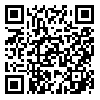1. Siegel LJ. Criminology. 11th edition. Belmont, Calif.: Wadsworth Publishing; 2012.
2. Livazović G. Role of family, peers and school in externalised adolescent risk behaviour. Croatian Journal of Rehabilitation Research. 2018;53:186–203.
3. Aliverdinia A, Younesi E. A step toward construction, validity and reliability of measurement scale for students’ deviant behaviors. Strategic Research on Social Problems in Iran. 2015;9(1):7–10. [Persian] [
Article]
4. Huck JL, Spraitz JD, Bowers JH, Morris CS. Connecting opportunity and strain to understand deviant behavior: a test of general strain theory. Deviant Behavior. 2017;38(9):1009–26. [
DOI]
5. Kohut JM. The application of general strain theory to college students and their misuse of prescription medication [Thesis for MSc]. [Youngstown, Ohio]: Youngstown State University; 2019.
6. Yoon W. The effect of job stress on college students' depression and suicidal ideation: based on the discussion of Agnew's general tension theory. Journal of Korean Public Police and Security Studies. 2016;13(1):95–118. [
DOI]
7. Jun S, Choi E. Academic stress and internet addiction from general strain theory framework. Comput Human Behav. 2015;49:282–7. [
DOI]
8. Shamsaei F, Yaghmaei S, Sadeghian E, Tapak L. Survey of stress, anxiety and depression in undergraduate nursing students of Hamadan University of medical sciences. Iranian Journal of Psychiatirc Nursing. 2018;6(3):25–30.[Persian] [
Article]
9. Lerner RM. Promoting positive youth development: theoretical and empirical bases. Washington, DC: National Academies of Science; 2005.
10. Damon W. What is positive youth development? Ann Am Acad Pol Soc Sci. 2004;591(1):13–24. [
DOI]
11. Larson RW. Toward a psychology of positive youth development. Am Psychol. 2000;55(1):170–83. [
DOI]
12. Benson PL, Scales PC, Syvertsen AK. The contribution of the developmental assets framework to positive youth development theory and practice. In: Kail R; editor. Advances in child development and behavior. Elsevier; 2011. pp: 197–230. [
DOI]
13. Scales PC, Benson PL, Roehlkepartain EC, Sesma A, van Dulmen M. The role of developmental assets in predicting academic achievement: a longitudinal study. J Adolesc. 2006;29(5):691–708. [
DOI]
14. Lerner RM, Benson PL. Developmental assets and asset-building communities: implications for research, policy, and practice. Boston, MA: Springer US; 2003.
15. Benson PL, Scales PC, Mannes M. Developmental strengths and their sources: Implications for the study and practice of community building. In: Larner RM, Jacobs F, Wertlieb D; editors. Handbook of applied developmental science: promoting positive child, adolescent, and family development through research, policies, and programs, band 1. London, United Kingdom: Sage Publications, Inc; 2003.
16. Leffert N, Benson PL, Scales PC, Sharma AR, Drake DR, Blyth DA. Developmental assets: measurement and prediction of risk behaviors among adolescents. Applied Developmental Science. 1998;2(4):209–30. [
DOI]
17. Jones-McKyer ELL. Relationships among developmental assets, age and smoking behaviors among youth [PhD dissertation]. [Indiana, United States]: Indiana University; 2005.
18. Search Institute Press. The asset approach: 40 elements of healthy development. Search Institute Press; 2006.
19. Jackson C. A study of the relationship between the developmental assets framework and the academic success of at-risk elementary to middle school transitioning students [PhD dissertation]. [Dallas]: Dallas Baptist University; 2010.
20. Masten AS, Obradovic J. Competence and resilience in development. Ann N Y Acad Sci. 2006;1094(1):13–27. [
DOI]
21. Larson R, Walker K, Pearce N. A comparison of youth-driven and adult-driven youth programs: Balancing inputs from youth and adults. J Community Psychol. 2005;33(1):57–74. [
DOI]
22. Mariano JM, Damon W. The role of spirituality and religious faith in supporting purpose in adolescence. In: Lerner RM, Roeser RW, Phelps E; editors. Positive youth development and spirituality: from theory to research. West Conshohocken, PA: Templeton Foundation Press. 2008. pp: 210–30.
23. Mohseni Tabrizi AR, Tabatabai M, Marjaei SH. Nazariye haye ravan shenakhti va rooykard talfighi mosharekat [Psychological theories and integrated approaches to participation]. Journal of Domestic Policy. 2006;1(1):147–76. [Persian]
24. Lerner RM, Dowling EM, Anderson PM. Positive youth development: thriving as the basis of personhood and civil society. Applied Developmental Science. 2003;7(3):172–80. [
DOI]
25. Benson PL, Scales PC. The definition and preliminary measurement of thriving in adolescence. J Posit Psychol. 2009;4(1):85–104. [
DOI]
26. Lerner RM, Jacobs F, Wertlieb D. Applied developmental science: an advanced textbook. London, Thousand Oaks: Sage Publications, Inc; 2005.
27. Pekrun R, Goetz T, Frenzel AC, Barchfeld P, Perry RP. Measuring emotions in students’ learning and performance: the Achievement Emotions Questionnaire (AEQ). Contemp Educ Psychol. 2011;36(1):36–48. [
DOI]
28. Higgins GE, Piquero NL, Piquero AR. General strain theory, peer rejection, and delinquency/crime. Youth & Society. 2011;43(4):1272–97. [
DOI]
29. Kline RB. Software review: software programs for structural equation modeling: Amos, EQS, and LISREL. J Psychoeduc Assess. 1998;16(4):343–64. [
DOI]
30. Search Institute. Developmental Assets Profile (DAP) [Internet]. 2005. [
Article]
31. Rezaei Varmazyar M. The relationship between perceived social support with psychological well-being: the mediator role of developmental assets. Developmental Psychology: Iranian Psychologists. 2019;15(58):175–88.[Persian] [
Article]
32. Azadian Bojnordi M, Bakhtiarpour S, Makvandi B, Ehteshamzadeh P. Internal and external developmental assets and academic well-being: the mediating role of academic buoyancy. Developmental Psychology: Iranian Psychologists. 2020;16(64):426–36.[Persian] [
Article]
33. Search Institute. Attitudes and Behaviour (A&B) Survey [Internet]. 2002. [
Article]
34. Hair JF, Hult GTM, Ringle CM, Sarstedt M. A primer on partial least squares structural equation modeling (PLS-SEM). Third edition. Thousand Oaks: Sage Publications; 2017.
35. Benson P, Scales PC, Hamilton SF, Sesma JA, Hong K, Roehlkepartain EC. Positive youth development so far: core hypotheses and their implications for policy and practice. Search Institute Insights & Evidence. 2006;3(1):1–16.
36. Agnew R. Pressured into crime: an overview of general strain theory. Los Angeles, Calif: Roxbury Publ; 2006.
37. Kołodziej S. The role of achievement motivation in educational aspirations and performance. General and Professional Education. 2010;(1):42–8.
38. Fonteyne L, Duyck W, De Fruyt F. Program-specific prediction of academic achievement on the basis of cognitive and non-cognitive factors. Learn Individ Differ. 2017;56:34–48. [
DOI]
39. Smith LH, Barker E. Exploring youth development with diverse children: correlates of risk, health, and thriving behaviors. J Spec Pediatr Nurs. 2009;14(1):12–21. [
DOI]





